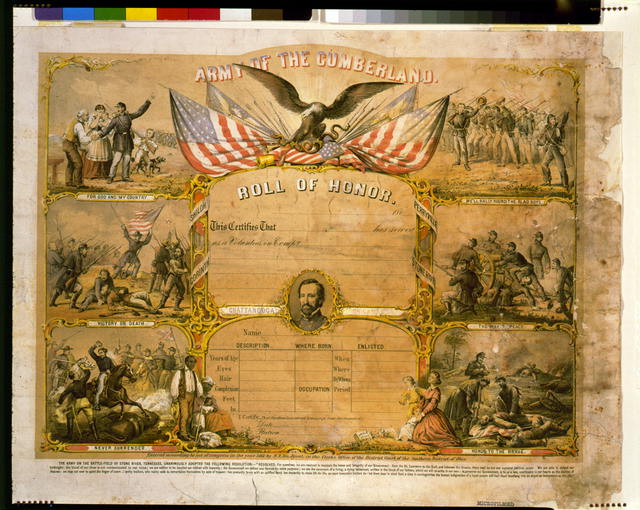 |
| Army of the Cumberland Roll of Honor (Library of Congress) |
Murfreesborough, February 20, 1863.
Major General H. W. HALLECK,
Washington, D. C.:
GENERAL: Captain [John C.] Peterson, acting assistant inspector-general, being obliged to change climate by medical direction, I avail myself of his zeal and intelligence to send you some details of this army, showing the percentage of absentees and the wear and tear of an army in battle. First, I find, from careful examination, that the average percentage of the present and absent now for the Fourteenth Army Corps
is 56.01 per cent., Twentieth Army Corps, 50.16 per cent., and Twenty-first Army Corps, 55.44 per cent. Presuming that each of these corps has fought but one great battle, in which they lost as follows, viz: Fourteenth Army Corps, 18.44 per cent., Twentieth Army Corps, 20.50 per cent., and Twenty-first Army Corps, 24.64 per cent., the average loss for the entire command being 20.03 per cent., we have before the battle the Fourteenth Army Corps had 63.42 per cent. present, the Twentieth Army Corps 64.60 per cent. present, and the Twenty-first Army Corps 66.93 per cent present.
Hence, before the battle, we have to pay 100 men for the above present, and we now have the preceding percentage for each 100 on the pay-roll. Although these are better results than I have expected, they are much worse than they ought to be. I am now endeavoring to bring the absentees to some rule, and reduce their numbers. The inspection system detects the illegal absentees, but it requires, in addition, the paymasters with the corps to know who ought not to be paid. Captain Peterson comes to show what means we use to detect absentees and what, even then, are our results. He is also charged to carry on a form of returns, which, if adopted in the Adjutant-General's Office and throughout the army, will force the various commanders to give such data in their returns as will afford means of knowing the true condition and strength of our forces, which, with the present forms in use, is not the case.
Very respectfully, your obedient servant,
W. S. ROSECRANS,
Major-General, Commanding Department.
Official Records, Series I., Vol. 23, Part 2, Pages 77-78.
Rosecrans developed a detailed interest in combat effectiveness numbers. After Stones River he computed the effectiveness of the fire of both sides by comparing opposing casualties per 100 men firing at them. Here he paints an interesting picture of both the impact of battle and how short of authorized complement organizations tended to be throughout the war.
No comments:
Post a Comment